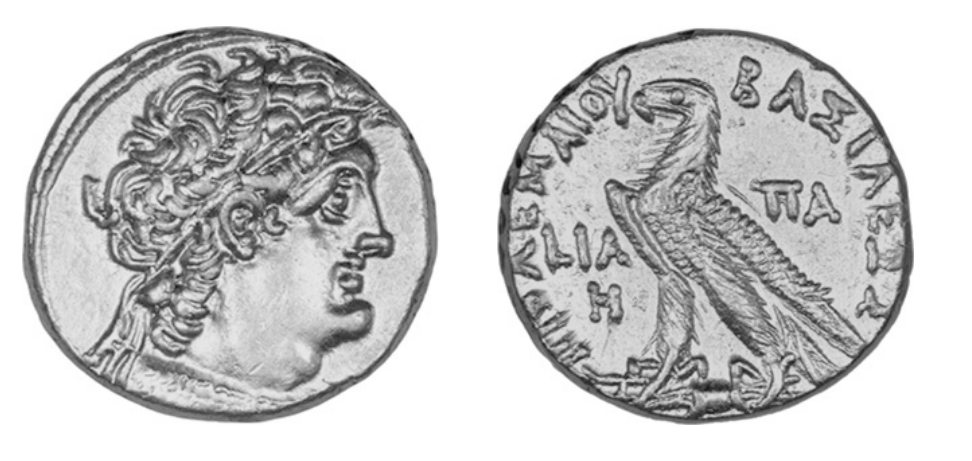S 678 - Alexandria, silver, tetradrachm, 107-101 BC
From SILVER
107 BCE - 101 BCE Silver 28,662 kg
Description
| ObverseInscription or printing placed on the obverse.: | Head of Ptolemy I Soter to right, wearing diadem and aegis around neck. |
| ReverseInscription or printing placed on the reverse.: | ΒΑΣΙΛΕΩΣ ΠΤΟΛΕΜΑΙΟΥ (Greek).Eagle standing to left on thunderbolt, date in field |
Mint and issuing power
| MintIdentifies the place of manufacture or issue of a numismatic object.: | Alexandria | Ancient regionAncient region.: | Egypt | Modern countryModern country: Egypt | AuthorityIdentifies the issuing power. The authority can be "pretended" when the name or the portrait of X is on the coin but he/she was not the issuing power. It can also be "uncertain" when there is no mention of X on the coin but he/she was the issuing power according to the historical sources: | Cleopatra III of Egypt (Ptolemaic queen, 142-131 and 127-116 BC), Ptolemy X Alexander I (Ptolemaic king, 110-88 BC) |
Chronology
| FromIdentifies the initial date in a range assigned in a numismatic context. | 107 BCE | toIdentifies the final date in a range assigned in a numismatic context.. | 101 BCE | PeriodTime period of the numismatic object.: Hellenistic 323-30 BC |
Physical description
| MetalThe physical material (usually metal) from which an object is made.: | Silver |
Median weightMedian of the weights of numismatic objects (in grams). in grams | 14.10 | DenominationTerm indicating the value of a numismatic object. Examples: tetradrachm, chalkous, denarius.: | tetradrachm |
StandardStandard.: | Ptolemaic |
References
| Die study referencePublication of the study: | Olivier 20121Olivier 2012, p. 234-240, no. 5799-6049. | ||
| Coin series referenceReference to coin series study: | |||
Obverse dies distribution
| FrequencyFrequency of specimen in distribution. ᵖ | Number of obversesNumber of obverse dies. ᵖ (o) | % (o) | Number of coinsNumber of coins. (n) | % (n) | Die nameName(s) of the die(s). |
| 1 | 28 | 34.57 | 28 | 11.16 | D430, D439, D447, D462, D463, D464, D466, D467, D469, D470, D471, D472, D473, D481, D482, D483, D486, D487, D488, D489, D490, D493, D494, D506, D507, D508, D509, D510 |
| 2 | 16 | 19.75 | 32 | 12.75 | D431, D437, D443, D444, D446, D448, D449, D451, D457, D459, D460, D465, D468, D478, D480, D492 |
| 3 | 10 | 12.35 | 30 | 11.95 | D440, D445, D453, D456, D458, D475, D476, D479, D485, D496 |
| 4 | 7 | 8.64 | 28 | 11.16 | D441, D452, D477, D484, D495, D497, D501 |
| 5 | 6 | 7.41 | 30 | 11.95 | D434, D435, D450, D474, D499, D505 |
| 6 | 5 | 6.17 | 30 | 11.95 | D433, D442, D454, D461, D498 |
| 7 | 3 | 3.7 | 21 | 8.37 | D432, D438, D491 |
| 8 | 4 | 4.94 | 32 | 12.75 | D455, D502, D503, D504 |
| 9 | 1 | 1.23 | 9 | 3.59 | D455, D502, D503, D504 |
| 11 | 1 | 1.23 | 11 | 4.38 | D436 |
| Total | 81 of 81 | 99.99 | 251 of 251 | 100.01 |
Reverse dies distribution
no distribution is available
Quantification
| Number of obversesNumber of obverse dies. ᵖ (o) | 81 | Number of singletons (o1)The number of singleton coins. ᵖ | 28 |
| Number of reverse diesNumber of reverse dies. (r) | 117 | Number of coinsNumber of coins. (n) | 251 |
| Coins per obverse dieNumber of coins per obverse die. (n/o) | 3.1 | Coins per reverse dieNumber of coins per reverse die. (n/r) | 2.15 |
| Reverse per obverse ratioRatio of obverse dies divided by reverse dies. (r/o) | 1.44 | Percentage of singletons (o1)number of coins (n) divided by the number of singletons (o1) ᵖ | 34.57 % |
| Original number of dies (O) (Carter 1983 formula)The estimation of the number of coins according to Carter 1983 ᵖ | 101.64 | Coins struck if 20,000 as average productivity per dieCoins made if the average productivity for obverses (according to Carter) is 20,000. ᵖ | 2,032,800 |
| Original number of dies (O) (Esty 2011 formula)The estimation of the number of coins according to the singleton formula in Esty 2011 ᵖ (O) | 119.59 | Survival rate if 20,000 as average productivity per dieSurvival rate if average productivity is 20,000. ᵖ | 0.00012 |
| Coverage (o = % of O) (Esty 1984 formula)Esty 1984 - coverage (% of O) ᵖ (o = % of O) | 88.84% | Die productivity if survival rate 1/2,000Average productivity if survival rate is 1/2,000. ᵖ | 4,939 |
| Weight of silver (in kg) if 20,000 coins per die (O = Carter formula)Carter 1983 * Median weight * 20000 (*10 if gold or electrum) ᵖ | 28,662 kg <br /> 28,662 kg | Die productivity if survival rate 1/5,000Average productivity if survival rate is 1/5,000. ᵖ | 12,347.5 |
Remarks
References
- ^ Olivier, Julien (2012), Archè et Chrèmata en Egypte au IIe siècle avant J.-C. (204-81 av. J.-C.). Etude de numismatique et d'histoire, [Unpublished doctoral dissertation], Orléans University, 2012.
